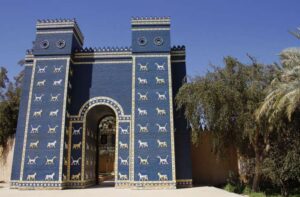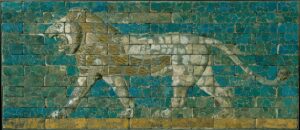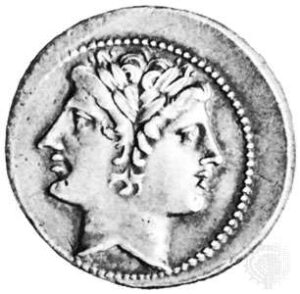The new year is a time for both reflection and projection. It encourages us to contemplate the trials and triumphs of the year, but it also provides us with the opportunity to look forward to what lies ahead with hope. This year, in particular, people around the globe are eager to ring in a new year, with optimism for a return to a more normal world. As we all look to the future with anticipation, we give pause to examine one of humanity’s first new year celebrations- Akitu.
Sometimes called Akitum, Akitu was a twelve-day celebration originating in ancient Mesopotamian Babylon. Beginning at the start of the spring and coinciding with the first sowing of barley, the festival marked the start of the Babylonian calendar. Akitu was more than a simple agricultural festival, however, it was a vehicle for political and social change, and it became central to the Babylonian religion over time.

Rconstruction of the Ishtar Gate at the ruins of Babylon, in modern day Iraq © Jukka Palm/Dreamstime.com
Festivities and rites were mostly conducted in two locations, the Ésagila (temple of the supreme god Marduk) and the ‘house of the New Year.’ The priest of the Ésagila would begin the festival with a series of pleading prayers to Marduk, answered by other priests and citizens with additional calls for protection and forgiveness. This continued for three days, purportedly an expression of fear of the unknown and the chaotic forces of the ancient world. At the end of the fourth day, the priest would recount the earliest Babylonian myth of creation and the ascension of Marduk as the supreme deity over the primordial gods.
During this time, the King of Babylon was required to leave the city and relocate to a temple in the city Borsippa, 17 kilometers south of Babylon. The king would reenter Babylon on the fifth day of Akitu, and enter the Ésagila. There, the priest acting as Marduk would strip the king of all refinery: jewelry, weapons, and even his scepter and crown. The king pled with Marduk that he had ruled without sin, at which point the priest would forcefully slap the king across the face in the hopes of inducing tears. A tearful king served as a symbol of the king’s submission to a higher power. Once the requisite tears were shed, the king would be returned his regalia, imbued with the divine power to rule another year. The festival then continued with several days of reenacting battles between gods using statues and puppets.
The celebration ended with the presentment of the holy statues to the people of Babylon via a parade led by the king. Babylonian government officials would make speeches about the city’s policies for the incoming year. This policy was seemingly always one of blessing, fortune, and success. It was well received by the populace, who would reply with the joyous singing of various hymns.

Photo courtesy of Metropolitan Museum of Art
Remnants of the Babylonian new year celebration are in museums around the world, including a glazed brick panel at the Metropolitan Museum of Art (the “Met”). It depicts a striding lion, circa 604-562 B.C. The lion is one of many that decorated the Processional Way, leading from the inner city through the Ishtar Gate to the house of the New Year. It would have presided over the parades of deities during Akitu. Lions are a symbol of the goddess Ishtar, wife to Marduk, and whose image was evoked to protect this most important street in Babylon. The Ishtar Gate was built by Nebuchadnezzar II, who brought the Babylonian empire to new heights through his mastery of diplomacy and warfare, as described by Herodotus and the Old Testament.
The piece owned by the Met was excavated in 1902 by German archeologist, Robert Koldewey, on behalf of the Deutsche Orient-Gesellschaft (German Oriental Society). Koldewey is highly regarded for directing the first prominent excavation of Babylon, which employed more than 200 people daily, year-round, from 1899 to 1914. He is credited with the discovery of the Ishtar Gate and the Processional street, where this piece was likely found. He also pioneered advanced methods of identifying and excavating mud brick architecture. In addition, he claimed to have discovered the famed Hanging Gardens of Babylon built by King Nebuchadnezzar. However, subsequent findings and analysis shed some doubt on this conclusion.
The excavation of Babylon generated considerable excitement in Germany, and thus Koldewey’s excavation was accordingly well funded during its fifteen years. The glazed piece was ceded to one of Germany’s national museums, the Vorderasiatisches Museum in Berlin. The institution boasts one of the world’s largest collections of ancient Middle Eastern and Southwest Asian art, including artifacts from historically important cities such as Uruk, Shuruppak, Assur, Hattusha, Tell el Amarna, Tell Halaf (Guzana), Sam’al, and Toprakkale. The Ishtar Gate itself resides within the Berlin museum, reconstructed after its excavation in Babylon. The glazed brick panel was acquired by the Met in 1931.

The god Janus, Roman coin; in the Bibliothèque Nationale, Paris
Larousse
The celebration of Akitu includes timeless aspects of new year celebrations. Dating back to the first civilizations, humans have taken stock at the end of the year and set goals for what to achieve in the twelve months to come. The practice of Akitu, which became popular throughout Mesopotamia, did not end with the fall of Babylon. By the third century A.D., Akitu was celebrated in Syria to honor of the sun god Elagabal. The holiday even made its way to Italy for a time via the Roman emperor Elagabalus, a Syrian native, who adopted the holiday during his short reign from 218 to 222. But the festival was not adapted as a celebration of the new year. The Romans continued to celebrate the occasion at the start of month of Janus, eventually becoming the new year we celebrate today.
Happy New Year from all of us at Amineddoleh & Associates!
My brother bookmarked this website for me and I have been going through it for the past several hrs. This is really going to help me and my friends for our class project. By the way, I enjoy the way you write.